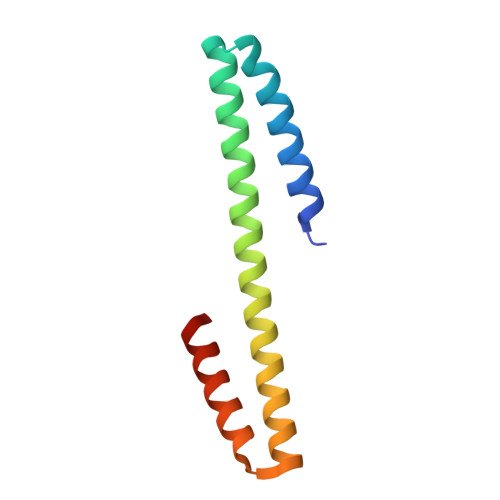Computational design of closely related proteins that adopt two well-defined but structurally divergent folds.
Wei, K.Y., Moschidi, D., Bick, M.J., Nerli, S., McShan, A.C., Carter, L.P., Huang, P.S., Fletcher, D.A., Sgourakis, N.G., Boyken, S.E., Baker, D.(2020) Proc Natl Acad Sci U S A 117: 7208-7215
- PubMed: 32188784
- DOI: https://doi.org/10.1073/pnas.1914808117
- Primary Citation of Related Structures:
6NX2, 6NXM, 6NY8, 6NYE, 6NYI, 6NYK, 6NZ1, 6NZ3, 6O0C, 6O0I - PubMed Abstract:
The plasticity of naturally occurring protein structures, which can change shape considerably in response to changes in environmental conditions, is critical to biological function. While computational methods have been used for de novo design of proteins that fold to a single state with a deep free-energy minimum [P.-S. Huang, S. E. Boyken, D. Baker, Nature 537, 320-327 (2016)], and to reengineer natural proteins to alter their dynamics [J. A. Davey, A. M. Damry, N. K. Goto, R. A. Chica, Nat. Chem. Biol. 13, 1280-1285 (2017)] or fold [P. A. Alexander, Y. He, Y. Chen, J. Orban, P. N. Bryan, Proc. Natl. Acad. Sci. U.S.A. 106, 21149-21154 (2009)], the de novo design of closely related sequences which adopt well-defined but structurally divergent structures remains an outstanding challenge. We designed closely related sequences (over 94% identity) that can adopt two very different homotrimeric helical bundle conformations-one short (∼66 Å height) and the other long (∼100 Å height)-reminiscent of the conformational transition of viral fusion proteins. Crystallographic and NMR spectroscopic characterization shows that both the short- and long-state sequences fold as designed. We sought to design bistable sequences for which both states are accessible, and obtained a single designed protein sequence that populates either the short state or the long state depending on the measurement conditions. The design of sequences which are poised to adopt two very different conformations sets the stage for creating large-scale conformational switches between structurally divergent forms.
Organizational Affiliation:
Department of Biochemistry, University of Washington, Seattle, WA 98195.














